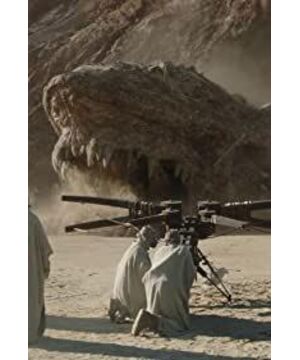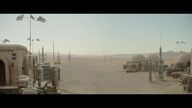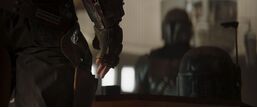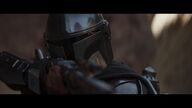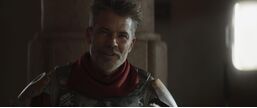With the end of the 16th episode (the eighth episode of the second season) of "The Mandalorian" on December 18 last year, Star Wars fans fell into a collective carnival. In the last 14 minutes of this episode, the great Jedi came like a saint child, single-handedly overturned the chilling group of dark soldiers, and instantly awakened with a series of familiar movements and styles (face-changing techniques) Almost vague memory. Even though this kind of bridge is a naked sales feeling, it is indeed placed in a reasonable plot design, and it can be effective enough to agitate the enthusiasm of fans, and it is beyond criticism in terms of image expressiveness.
The two seasons of "The Mandalorian" have been broadcast, and the overall quality is quite high, even attracting many non-Star Wars fans. In my opinion, the length of this single episode is about the same as that of the sitcom, and the short episodes of each season are somewhat "stretched", which more accurately grasp the unique expression of Star Wars than the huge new trilogy. , And at the same time truly achieve the four-character motto of "short and fierce", it can be said that it is the best live-action video work since 2016 "Rogue One". The series not only inherited the style of the Star Wars True Story trilogy very well, but also started from a special narrative text to extend an expression angle different from the main line works, which greatly enriched the cultural landscape of the Star Wars universe.
More essentially, the seemingly conservative structure, old-fashioned themes, the same narrative clues of "The Mandalorian", there is no lack of loopholes in the event logic, straightforward emotional curves, and even the simple retro visual details, maybe in other There are flaws in the work, but it is precisely the cornerstone of this series's success, and it is the magic weapon for the "Star Wars" series to survive. The reason why the new trilogy is mixed and controversial is that it lost these bricks and tried to carry out the so-called innovation. On the contrary, it lost the "old" and "outdated" charm. If there is a simple and concise secret for Star Wars to be popular all over the world, then this formula has been revealed to the world countless times in the movie-"A long, long time ago, in a distant galaxy...".
In other words, the core charm of Star Wars has long been summarized in the opening subtitles of each movie, and there is no need to over-explain its implication. But there are always people who ignore it, or deliberately ignore it, so that they can't understand why Star Wars has so many fans. The new generation of audiences habitually misunderstand this series as an entertainment science fiction film about space wars, or a magnificent and empty space opera, just because there are piles of aliens and high-tech unclear principles. This perception may be narrow. If the label-style summary holds true, then "Star Wars" should be completely dead during the prequel trilogy-there are too many sci-fi works that can perfectly replace it. Perhaps, the first film in 1977 was indeed reliant on visual spectacles to shock the world at the beginning, but if there is no alternative artistic interest that radiates with it, it is difficult to have a long shelf life by computer special effects, and it will not achieve the following decades. development path.
On the surface, even though Star Wars is a story about cosmic wars and personal heroism adventures, rendering the romantic atmosphere of strong science fiction adventures and space operas, it is difficult for us to one-sidedly define it as a science fiction movie in the general sense (Sci- Fi), at least not a science fiction film described by traditional typology. The reason why it has occupied a place in popular culture for a long time is that there must be a more pure aesthetic core behind it. The cumbersome and even some incompatible image elements it contains, such as science fiction, western, action, suspense, political thriller, etc., have undoubtedly formed some kind of web-like text and ultra-stylisticism after the mess. The effect of a layer of veil superimposed. Under the general genre framework, the classification of Sci-Fi films is no longer sufficient to accommodate all the characteristics of this series. In fact, "Star Wars" has always been summarized in a larger and more vague paradigm like Fantasy, which proves that it is difficult to summarize briefly.
In this magnificent narrative space, there are not only spaceships, robots, aliens, and alien planets, but also conventional sci-fi settings, but also a lot of non-sci-fi designs, such as dirty armors and weapons, and run-down streets. , The primitive lifestyles and customs of some marginal villages and races, the overall visual design does not have a distinct sense of the future. In particular, the Jedi Knights are the most representative group, which is obviously "out-of-time". They are nothing more than concrete depictions of the abstract time scale of "a long time ago." The theme of the series has never been to explore the relationship between technology and life, or the anxiety and vigilance about the future, and does not provide obvious humanistic criticism and realistic reflection. Looking at the existing serious science fiction themes, Star Wars is obviously lacking in depth and even unqualified.
As a result, as soon as "Star Wars" came out, it not only quickly became one of the most important cultural phenomena in the world, but also changed the history of genre movies. In fact, its essence is a classicist drama dressed in a sci-fi coat. It is an extension of the mainstream entertainment and genre movies of the last century. It contains mysticism, an oriental complex, and emphasizes the beauty of modeling and a sense of ritual. It is epoch-making in visual effects, and it is undoubtedly very nostalgic in terms of core aesthetics. The religion, cosmology, and heroism contained in it not only condense a heavy philosophical myth intentionally or unconsciously, but also make it a modern myth in the true sense. The reason why these old style materials can shine is due to the overall aesthetic characteristics of Star Wars from appearance to interior, and the transformation of the worldview narrative strategy. This determines that Star Wars was expressed in a state of completeness from the beginning of its birth, and effectively allowed these eternal abstract themes to be widely accepted. This is why after losing the advantage of visual effects in the 21st century, "Star Wars" still has plenty of appeal and broad development space.
When we arrange, refine and analyze one by one from the many style elements it contains, it is not difficult to find the aesthetic prototype hidden behind Star Wars. At this point, although we can trace back to Shakespeare, the Bible, ancient Greek poetry, or the Renaissance, after all, a complete set of modern narrative systems in the West have basically developed since then, but they are all inherently low-level. Gene, there is not much room and necessity for discussion. Another more representative path of the Star Wars series is to absorb a lot of popular entertainment culture from the 1950s to the 1970s, including novels, movies, dramas, comics, and so on. It stands on the shoulders of giants, and through imitating, appropriating, and rewriting, it finally becomes its own faction. Among them, these inspiration fragments are dominated by Japanese movies with the image of samurai/ronin as the main character and the main stage of the Warring States period.
Fundamentally, "Star Wars" is a huge and typical memetic template. Its obvious roots are wrapped in the ancient costume film pedigree of Kurosawa Akira, Okamoto Kihachi, Kobayashi Masaki, and Fujita Toshihachi. It is the Japanese Warring States Period. The most vivid example of culture taking root overseas. Not only did the first "Star Wars" (now called "New Hope") directly use Akira Kurosawa's "Warring States Heroes" in the narrative context, the most eye-catching Jedi in the series is also born out of the image of the ronin on the screen. , And among the Jedi/Sith warriors, the most characteristic of the Japanese Warring States period is Darth Vader. His life support suit is obviously a deformation of the helmet and armor during the Warring States period. In addition, the broken hands of the decisive battle scenes in several films are actually from another work by Akira Kurosawa, "Intentional Stick". R2D2 and C3PO are inspired by the little servant characters in most of the Warring States movies, and Master Yoda is an alien version of Kanbei in "Seven Samurai".
Until "The Mandalorian", the entire storyline of Ding Jaren's escape with Baby Yoda is easily reminiscent of "The Wolf with the Tie". The first few paragraphs of the relationship between the characters in the first season almost reproduce the same complexity and anxiety between the characters in "Intentional Stick". In the fourth episode of the first season, we can clearly feel the taste of "Black Warrior", bounty hunters and friends help the villagers resist evil. In the fifth episode of the second season, the story about Ahsoka, we can also easily see that the scenes, props and lights in the frame are deliberately close to the atmosphere of the Warring States period-high walls and towers, and a sluggish residence. Districts and arbitrary rulers. These obvious audio-visual elements have clearly revealed the imitation of "The Mandalorian" to the old Japanese movies, and in the setting, scheduling, soundtrack and performance style, it is undoubtedly a re-enactment of the Japanese Sengoku film/ronin film/Sword Halberd. The context of the film.
It is this kind of rhyme that made the "Star Wars" of forty years ago become famous, and it also made the "Mandalorian" of today stand out. The foundation for the survival of the Star Wars series is continuously consolidated in the continuous re-creation of the samurai film culture in the Western context. On the other hand, we can also perceive the huge influence of Western movies on Star Wars. From Han Solo to the bustling bars, from the town sheriff, bounty hunter, wilderness duel to the focus on the depth of the camera scheduling, all implied the character of Western film. And if you remember the lawsuit between Akira Kurosawa and Sergio Leon, you will never forget the ambiguous intertextuality between samurai films and western films, even if they started to develop almost at the same time, they will soon Begin to learn from each other, and then form the theme of similarity in different historical and social contexts.
Just like "Rogue One", "The Mandalorian" also focuses on a group of small characters, deliberately different from the grand narrative of the mainline trilogy movie. Ding Jaren, who is reticent, does not have the natural protagonist aura of the Skywalker family, nor the ability to change his fate. He is just a mixture of a typical Ronin and a cowboy. Under the professional ethics of a bounty hunter, he has both the cowboy manner of life and the inner temperament of a ronin, which turns into his slightly erratic sense of morality and adherence to the group dogma. As a fundamentalist Mandalorian, he couldn't bear the armor of the same race falling into the hands of other people, just as a samurai couldn't bear a civilian holding a katana. In the face of a new generation of Mandalorian forces like Bo-Catan Kritz, he would question why the opponent took off his helmet casually, just as he questioned the same class of people abandoning Bushido. At the same time, he is loyal and righteous to his companions, respects promises, and has an unwavering determination to goals. Ronin is a samurai who has lost his identity. From this perspective, Ding Jaren has been out of touch with his tribe for a long time and embarked on an escape journey alone. He is an out-and-out Ronin.
And this fugitive who seized "goods" and betrayed the Chamber of Commerce, 90% of the time, was covered in iron sheets, and seemed to give us no chance to observe his expression and realize his inner heart. But this did not prevent us from taking on this role, on the contrary, it was easy to capture his emotions and personality. The reasons are firstly the actor's clever control over the rhythm of body movements when performing without a face, as well as the tone, pitch and wording of the lines. Another more important aspect is that he has assembled the characteristics of many classic screen images and designed a large number of dramatic scenes that express the charm of such images. This, of course, will make the character's connotation seem a bit flat and somewhat facial, but it also allows the audience to quickly enter the situation and identify with the character. And whenever Ding Jaren is forced to take off his helmet, the emotional tension becomes stronger. This circumstantial transfer method gave him a personality that is different from other types of characters, making him another iconic character in the Star Wars universe.
On the other hand, the 16 episodes of "The Mandalorian" follow the journey narrative structure, but it is not a typical road film routine. To some extent, it is not so much a road movie, but more like a narrative rhythm close to the game. Almost every episode is a commissioned task, while pushing the main line forward a little bit. Some tasks are taken on the initiative, while others are forced. Ding Jialun accumulates equipment resources in the process of constantly completing tasks and constantly switching scenes, and finally arrives at his destination, which is like a linear narrative game. At certain moments, such a play strategy may give us a sense of boring repetition, and the director of each episode has a strong or weak control over different narrative units, and there will be ups and downs in viewing. Fortunately, this group creation model finally took hold of the direction, making the whole drama maintain a relatively average level.
In the final set of easter eggs, we see Boba Fett sitting on Jabba’s dragon chair. It seems that Din Jaren’s story is about to come to an end, and the next chapter should be "The Book of Boba Fett" . In any case, "The Mandalorian" is a successful attempt of the Star Wars series, more successful than the new trilogy, and has also made outstanding contributions to the expansion of the Star Wars universe. For passers-by and fans, this series is a low-threshold delicacy where you can enjoy the authentic Star Wars flavors. I hope that the creators will continue to carry forward the classicism of Star Wars and never lose the core charm and interest of the series. This is the right way! This is the way!
View more about Chapter 9: The Marshal reviews


